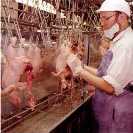US poultry plants with lower risks to receive fewer inspections

“There are certain food products that carry a higher inherent risk than others,” said Richard Raymond, the Agriculture Department’s top food safety official. “There are certain plants that do a better job of controlling risk than others.”
The first major changes to food inspection in a decade will increase federal scrutiny of meat and poultry plants where the danger from E. coli and other germs is high or where past visits have found unsafe practices. The new policy will result in fewer inspections at plants with lower risks and better records for handling meat and poultry.
To decide the level of scrutiny a plant should get, the “risk-based” system will consider the type of product and the plant’s record of food safety violations. A plant that makes hamburger and has repeated violations would get more inspection. A plant that makes cooked, canned ham and has a clean track record would get less scrutiny.
The risk-based inspection system will be the most significant change to food safety inspections in a decade. The department overhauled inspections in 1996 when hundreds of people got sick and four children died after eating undercooked hamburgers from Jack in the Box restaurants.
For now, the new system will be used in processing plants, not in slaughter plants. No timetable has been set for shifting to the new inspection system, although the Agriculture Department is expected to release one within the next few weeks .
For now, the new system will be used in processing plants, not in slaughter plants. No timetable has been set for shifting to the new inspection system, although the Agriculture Department is expected to release one within the next few weeks .













